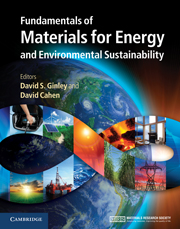Book contents
- Frontmatter
- Contents
- Contributors
- Preface
- Acknowledgments
- Part 1 Energy and the environment: the global landscape
- Part 2 Nonrenewable energy sources
- Part 3 Renewable energy sources
- 17 Solar energy overview
- 18 Direct solar energy conversion with photovoltaic devices
- 19 Future concepts for photovoltaic energy conversion
- 20 Concentrating and multijunction photovoltaics
- 21 Concentrating solar thermal power
- 22 Solar thermoelectrics: direct solar thermal energy conversion
- 23 Off-grid solar in the developing world
- 24 Principles of photosynthesis
- 25 Biofuels and biomaterials from microbes
- 26 Biofuels from cellulosic biomass via aqueous processing
- 27 Artificial photosynthesis for solar energy conversion
- 28 Engineering natural photosynthesis
- 29 Geothermal and ocean energy
- 30 Wind energy
- Part 4 Transportation
- Part 5 Energy efficiency
- Part 6 Energy storage, high-penetration renewables, and grid stabilization
- Summary
- Appendix A Thermodynamics
- Appendix B Electrochemistry
- Appendix C Units
- Index
- References
27 - Artificial photosynthesis for solar energy conversion
from Part 3 - Renewable energy sources
Published online by Cambridge University Press: 05 June 2012
- Frontmatter
- Contents
- Contributors
- Preface
- Acknowledgments
- Part 1 Energy and the environment: the global landscape
- Part 2 Nonrenewable energy sources
- Part 3 Renewable energy sources
- 17 Solar energy overview
- 18 Direct solar energy conversion with photovoltaic devices
- 19 Future concepts for photovoltaic energy conversion
- 20 Concentrating and multijunction photovoltaics
- 21 Concentrating solar thermal power
- 22 Solar thermoelectrics: direct solar thermal energy conversion
- 23 Off-grid solar in the developing world
- 24 Principles of photosynthesis
- 25 Biofuels and biomaterials from microbes
- 26 Biofuels from cellulosic biomass via aqueous processing
- 27 Artificial photosynthesis for solar energy conversion
- 28 Engineering natural photosynthesis
- 29 Geothermal and ocean energy
- 30 Wind energy
- Part 4 Transportation
- Part 5 Energy efficiency
- Part 6 Energy storage, high-penetration renewables, and grid stabilization
- Summary
- Appendix A Thermodynamics
- Appendix B Electrochemistry
- Appendix C Units
- Index
- References
Summary
Focus
In natural photosynthesis, organisms optimize solar energy conversion through organized assemblies of photofunctional chromophores and catalysts within proteins that provide specifically tailored environments for chemical reactions. As with their natural counterparts, artificial photosynthetic systems for practical production of solar fuels must collect light energy, separate charge, and transport charge to catalytic sites where multielectron redox processes occur. Although encouraging progress has been made on each aspect of this complex problem, researchers have not yet developed self-ordering components and the tailored environments necessary to realize a fully functional artificial photosynthetic system.
Synopsis
Previously, researchers used complex, covalent molecular systems comprising chromophores, electron donors, and electron acceptors to mimic both the light-harvesting (antenna) and charge-separation functions of natural photosynthetic arrays. These systems allow one to derive fundamental insights into the dependences of electron-transfer rate constants on donor–acceptor distance and orientation, electronic interaction, and the free energy of the reaction. However, significantly more complex systems are required in order to achieve functions comparable to natural photosynthesis. Self-assembly provides a facile means for organizing large numbers of molecules into supramolecular structures that can bridge length scales from nanometers to macroscopic dimensions. To achieve an artificial photosynthetic system, the resulting structures must provide pathways for the migration of light excitation energy among antenna chromophores, and from antennas to reaction centers. They also must incorporate charge conduits, that is, molecular “wires” that can efficiently move electrons and holes between reaction centers and catalytic sites. The central challenge is to develop small, functional building blocks that have the appropriate molecular-recognition properties to facilitate self-assembly of complete, functional artificial photosynthetic systems.
- Type
- Chapter
- Information
- Publisher: Cambridge University PressPrint publication year: 2011
References
- 1
- Cited by



